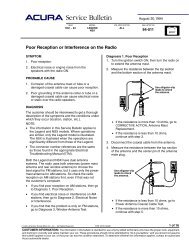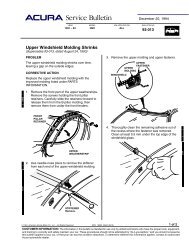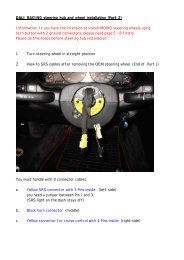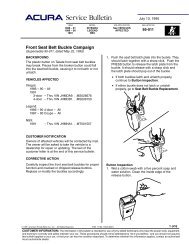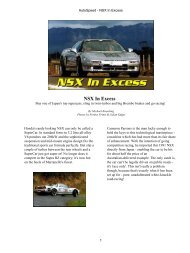TSB NSX Pre-Delivery Inspection - Dali Racing
TSB NSX Pre-Delivery Inspection - Dali Racing
TSB NSX Pre-Delivery Inspection - Dali Racing
- No tags were found...
You also want an ePaper? Increase the reach of your titles
YUMPU automatically turns print PDFs into web optimized ePapers that Google loves.
April 4, 1995YEAR MODEL VIN APPLICATION BULLETIN NO.1995 <strong>NSX</strong> ALL95-006TQI<strong>NSX</strong>: PDI InformationIn addition to the normal PDI procedures, the 1995<strong>NSX</strong> has new features that should be checked duringpre-delivery inspection.REMOVABLE ROOFSeveral new items are added to accommodate theremovable roof on the <strong>NSX</strong>-T. They should bechecked during PDI.• The Door and Lamp Monitor on the instrumentpanel has an added Roof Unlatched Indicator.This indicator lights when the roof is in place butone or both of the roof latches are not fullylatched, or when the roof is removed but notproperly stored in the holder.• The roof holder is on top of the engine cover. Thesensor switch for the Roof Unlatched Indicator islocated in the left front of the holder. This switchis not waterproof. It can be damaged if the roof isvery wet when it is stored, or by carelessnesswhen steam-cleaning the engine.• Engine heat while driving can cause the roof toget very warm. Always open the rear window andlet the car sit for several minutes with the engineoff before removing the roof from the holder.• Because of the added weight, do not try toservice the engine with the roof stored in theholder. Remove the roof from the holder beforepropping open the engine cover.• The car comes with two plugs (in the glove box)that can be used to reduce wind noise whiledriving with the roof removed. The plugs shouldbe installed in the holes in the tops of the “B”pillars. These are the only plugs that should beused.• To prevent creaks, the edges of the roof thatcontact the weatherstrip are covered with cleartape. The factory also applies silicone to theweatherstrips. If you hear creaks or squeakscoming from the roof, check the condition of thetape and the weatherstrips. Clean both thoroughly,then apply silicone grease (P/N 08798-9013) tothe weatherstrips. Massage it in thoroughly with aclean cloth, and wipe up any excess. Apply asmall amount of silicone grease to the hook stopat the top of each “A” pillar.HOOK STOPROOFROOF SIDEHOOK• The weatherstrips around the windows are veryfirm when they are new. The glass may not go allthe way up and seat properly if the the window isclosed with the door closed. To prevent waterleaks, close the windows with the doors openbefore washing the car.© 1995 American Honda Motor Co., Inc. – All Rights Reserved BTB 17086 (9504)1 of 2CUSTOMER INFORMATION: The information in this bulletin is intended for use only by skilled technicians who have the proper tools, equipment,and training to correctly and safely maintain your car. These procedures should not be attempted by “do-it-yourselfers,” and you should not assumethis bulletin applies to your car, or that your car has the condition described. To determine whether this information applies, contact an authorizedAcura automobile dealer.
AUTOMATIC TRANSMISSIONThe automatic transmission has a new “Sport Shift”mode. In this mode, the lever on the right steeringcolumn pod is used to shift the transmission.• To place the transmission in sport shift mode,move the console shift lever to the “M/3” position.If the car is not moving, the transmission will shiftto first gear. If the car is moving, and thetransmission is in first, second, or third gear, it willremain in that gear. If the transmission is in fourthgear, it will downshift to third. The gear number isdisplayed on the instrument panel.• With the transmission in M/3, it will remain in thesame gear unless it is shifted manually with thesteering column lever. The exceptions are:– The transmission will automatically upshift fromfirst to second gear when the engine reachesredline or the driver reduces pressure on theaccelerator pedal.– As the car comes to a stop, the transmissionwill downshift from fourth to third gear at20 mph, and then to first gear at 10 mph.• Even though the driver moves the lever, thetransmission will not shift under these conditions:– It will not shift into fourth gear below 20 mph.– When decelerating, it will not downshift intofirst gear unless the throttle is open.– It will not downshift if the redline would beexceeded in the lower gear.TRACTION CONTROL SYSTEMDue to the DBW, the TCS is now more sensitive andcan adjust engine output in finer steps than theprevious system. It also now works duringdeceleration to prevent wheel lockup duringdownshifting.The TCS now has only one instrument panelindicator. If performs these functions:• As a lamp check, it comes on when the ignitionswitch is first turned to ON.• It flashes when the TCS is regulating enginepower.• It comes on when the TCS is turned off manually.• It comes on when the TCS senses a problem inthe system.ON BOARD DIAGNOSTICSThe <strong>NSX</strong> has the On Board Diagnostics II system.The system’s Data Link Connector, for connectingthe Honda PGM Tester or other scan tool, is locatedon the knee bolster below the glove box. Refer tosection 11 of the service manual for completeinformation.WARRANTY CLAIM INFORMATIONNone; this information is considered part of normal PDI.MANUAL TRANSMISSIONCars equipped with the 5-speed transmission have atorque-sensing limited slip differential. Underacceleration, the pressure of the clutch packs isgreater, causing more lockup. Under deceleration,the clutch pack pressure is less, causing reducedlockup.ACCELERATOR LINKAGEThe <strong>NSX</strong> now uses a Drive By Wire (DBW) system.The accelerator pedal is connected electronically tothe ECM. From the accelerator pedal position, theECM tells the throttle control motor how to positionthe throttle valve.Because of the DBW, the procedure for setting theidle speed has changed. The SCS service connectormust be connected. Refer to service manual page11-128 for the complete procedure.2 of 2



![Keyless Remote Manual [pdf] - Dali Racing](https://img.yumpu.com/49994721/1/190x245/keyless-remote-manual-pdf-dali-racing.jpg?quality=85)
